For the perfect appetiser for entertaining, or simply a light meal, these deliciously soft and fluffy bread rolls with baked Camembert are sure to be a hit with your friends and family! Recipe with step-by-step photos.
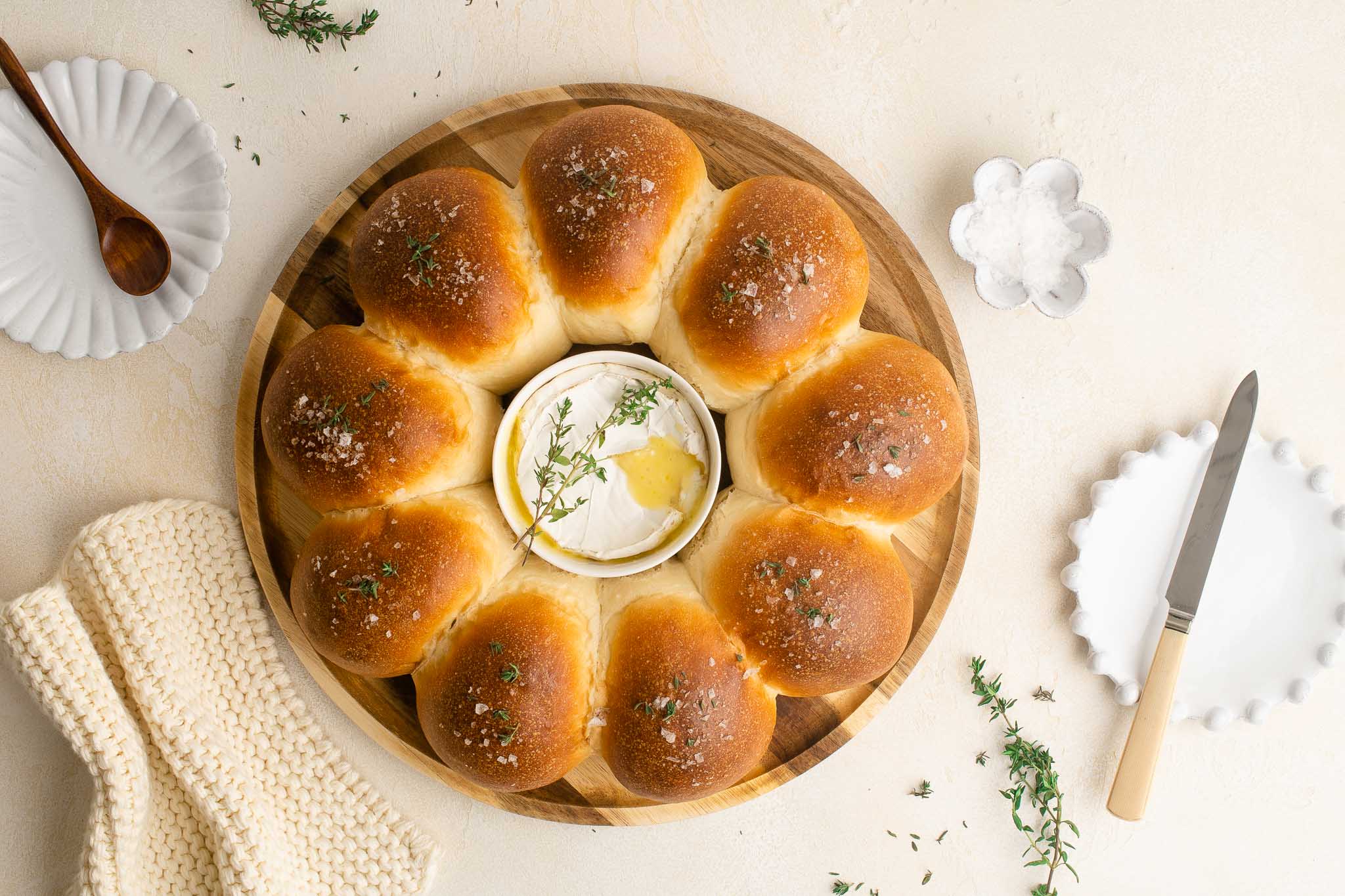
Baked Camembert Bread Rolls
Everybody loves freshly baked bread rolls, and what could be better than soft and fluffy bread rolls served alongside warm, oozy baked Camembert for a fun take on Cheese Fondue?
Baked Camembert Bread Rolls is something I like to make when we have friends over for drinks or nibblies, and I want to produce something homemade but not too complicated. This is perfect served alongside a plate of cold cuts, such as ham, salami, mortadella and/or proscuitto, as well as some cornichons and olives. Some chilled white wine would be perfect too!
In fact, for this style of entertaining, the only thing you are making are the fresh bread rolls; everything else can be shop-bought, which means less time in the kitchen, and more time with your friends 🙂
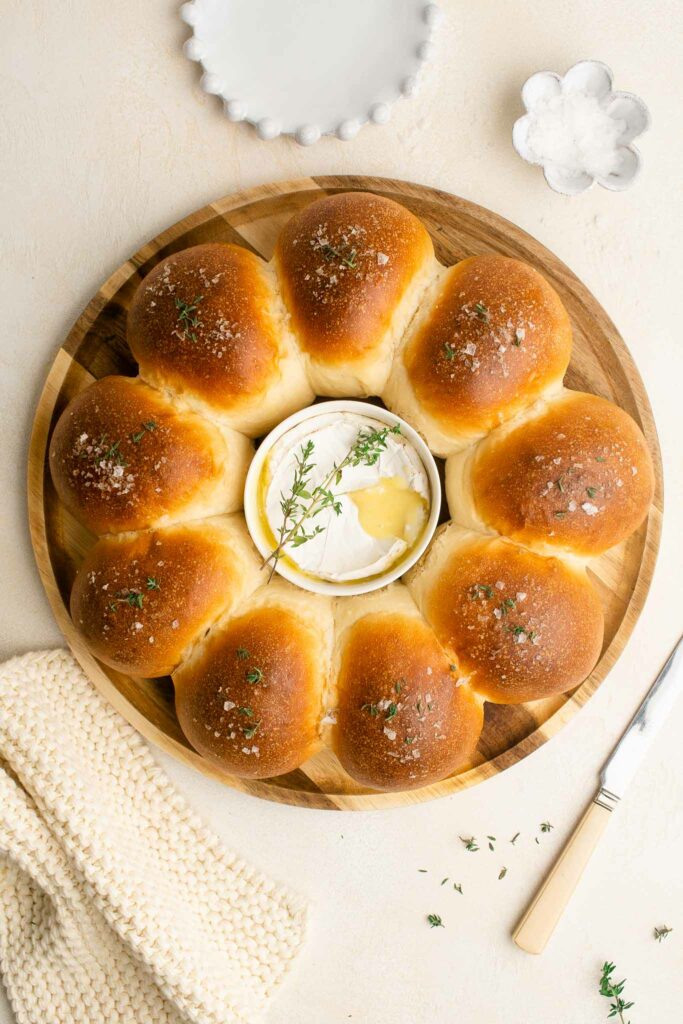
Baked Camembert Recipe
I like to use my recipe for Baked Camembert with Honey & Raspberries if I want to serve something dessert-like or on the sweet side.
For a more savoury appetiser, I like to turn the Camembert into a mini cheese fondue. Simply drizzle the Camembert with some white wine for that fondue-like scent and flavour, and bake for 10-15 minutes until the centre is bubbling and oozing.
To be honest, baked Camembert is not that popular amongst the Swiss and French; they prefer to have a proper fondue, and they would argue that there is nothing wrong with serving a regular cheese board at an Apéro. But I can see the appeal of serving a warm, baked cheese in the colder months, and when we have guests in our home, sometimes I think it is fun to offer them something a bit different 😉
Bread Roll Wreath Recipe
There are many recipes on the internet for pull-apart bread rolls with baked Brie or baked Camembert. One website which I found really helpful was at Breadtopia, where the author showed several creative ways to shape the bread rolls, including the flower shape which I have used in the recipe below. I definitely want to try some of her other ideas too!
This recipe produces 9 bread rolls, and I would say that each roll is a decent size for one person as part of a shared appetiser. However, be prepared for people to come back for second or third helpings!
If you want to make more rolls, or smaller rolls, you can adjust the recipe accordingly.
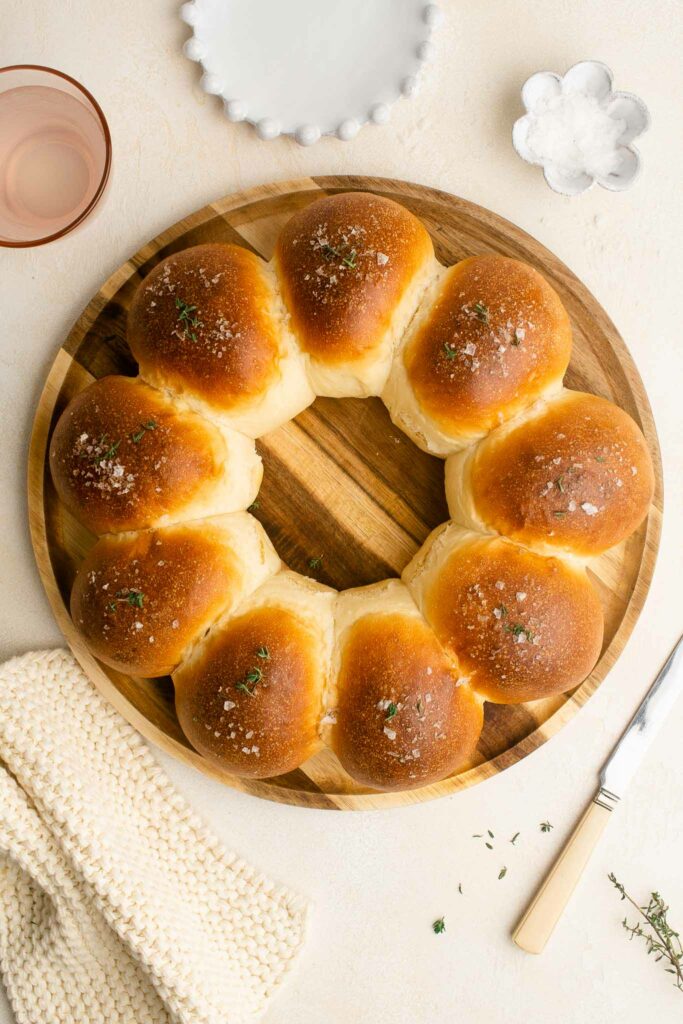
Bread Rolls Recipe
Below is my go-to recipe for soft and fluffy bread rolls which are perfect for tearing and sharing. The rolls are baked close together to allow them to rise and form tall bread rolls with a tenderly soft and pillowy centre.
If you are looking for soft dinner rolls, rolls for making sandwiches or hamburgers, or just soft bread rolls in general, this is the recipe you need. My parents ran a bakery in Australia when I was a child, and these bread rolls taste just like bakery-style white bread rolls.
I frequently use this recipe to make 9 to 12 bread rolls but, once in a while, it can be fun to change up the recipe slightly by forming the bread rolls into a wreath and baking some cheese in the centre.
How to Make Baked Camembert Bread Rolls
Step 1
Measure the flour, sugar, yeast and salt into the bowl of an electric stand mixer. Lightly mix the ingredients together.
Step 2
Slowly add the warm milk (you may not need all of it), and lightly beat everything with the dough hook until it comes together into a large ball of dough. Only add as much milk as you need to bring the ingredients together into a dough.

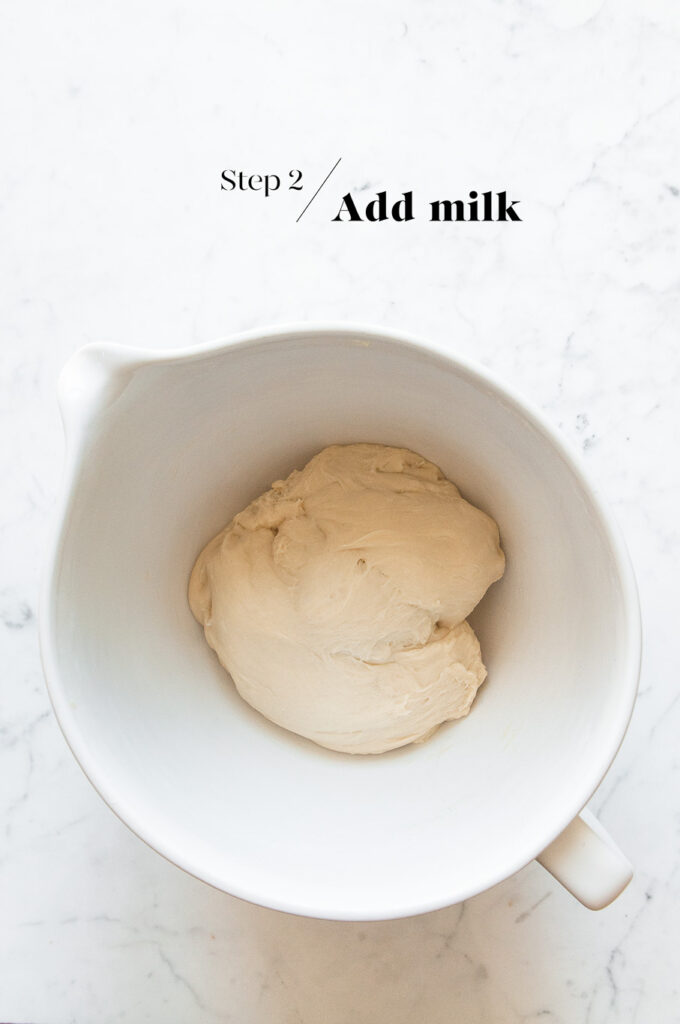
Step 3
Slowly incorporate the butter, one tablespoon at a time, until all of the butter has been used.
Then increase the speed to medium and continue kneading with the dough hook for 15 to 20 minutes, or until the dough is smooth and elastic.
Step 4
Lightly oil a large mixing bowl, and place the dough into the bowl. Cover the bowl with a clean tea towel and leave it somewhere warm for 1 to 1.5 hours, or until the dough has doubled in size.
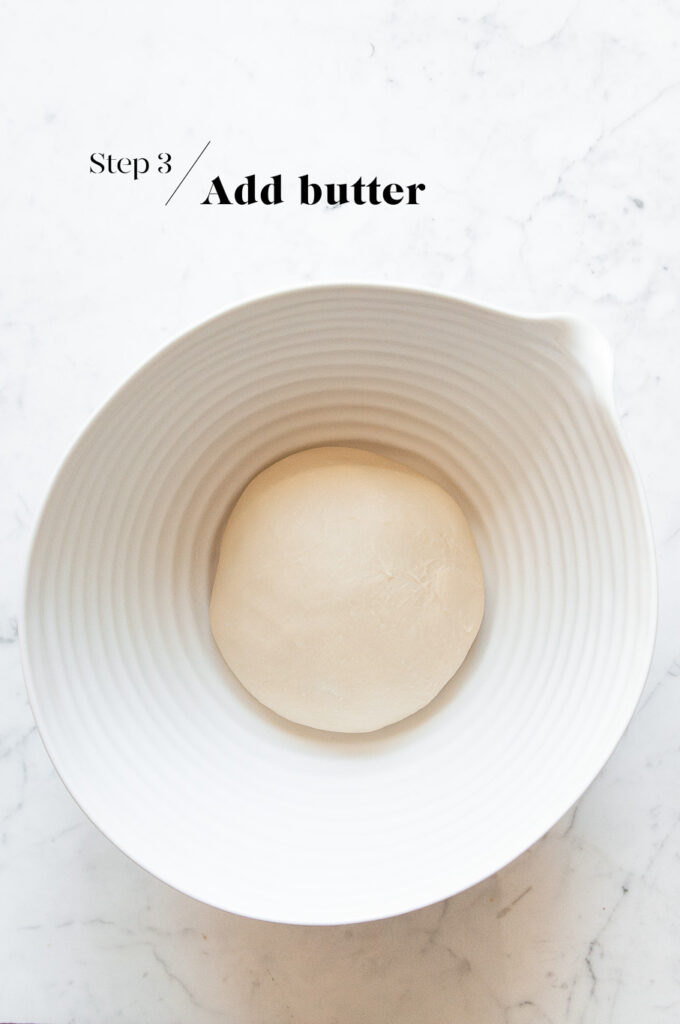
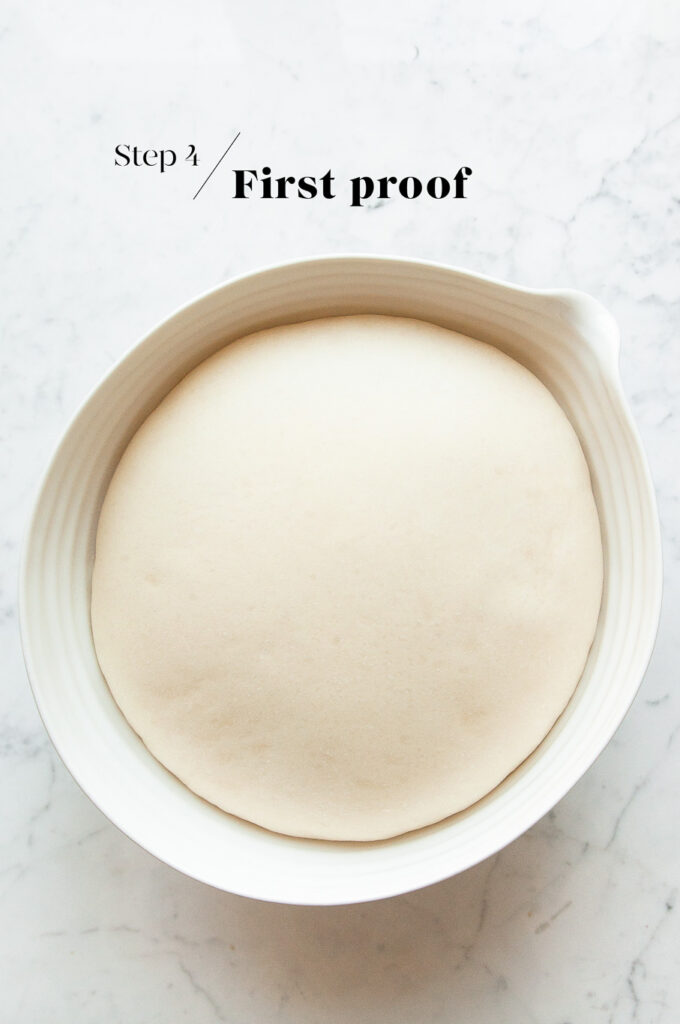
Step 5
Once the dough has doubled in size, gently remove the dough from the bowl. The dough will deflate as you handle it.
Cut the dough into 9 equal portions. I like to do this by weighing the dough, and then dividing this number by 9 to get the weight for each ball of dough.
Roll each piece of dough into a smooth ball by pulling the edges together to form a ball, pinch the edges together, and roll gently until you have a smooth ball.
Gently roll each ball of dough into a slightly oval shape.
Place the shaped dough onto the lined baking tray, around a ramekin which will fit the cheese. Place the buns somewhat close together so that they will touch each other after the second proofing.
Step 6
Place the tray of buns somewhere warm for about 30 minutes to puff up slightly. As they rise, the buns will touch each other and resemble petals on a flower. Note that, during baking, the buns will rise and expand even more.
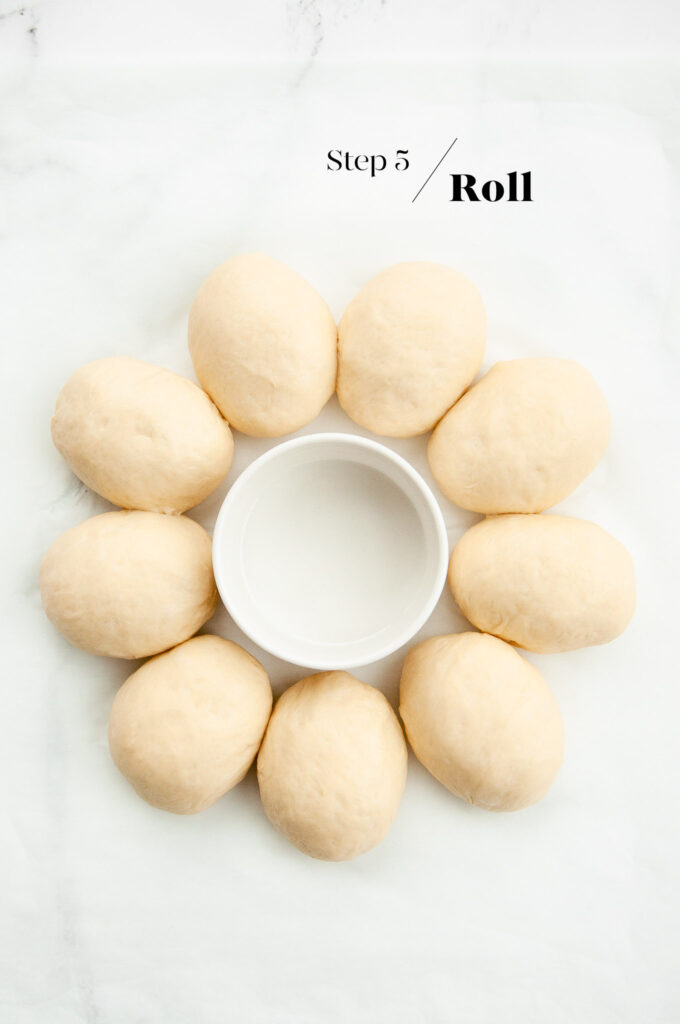
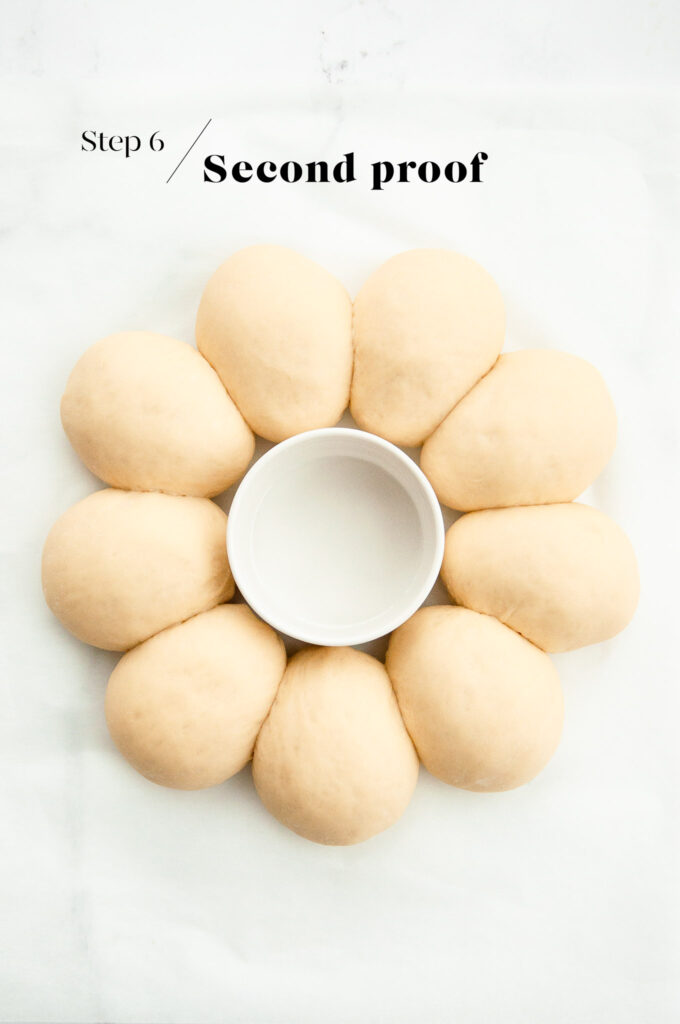
Step 7
Preheat the oven to 220°C/390°F (without fan). Place a metal baking tray in the middle of the oven.
Brush the buns with some milk and sprinkle with coarse sea salt.
Bake the buns for 10 minutes.
Step 8
Reduce the oven temperature to 180°C/356°F (without fan).
Remove the baking tray from the oven.
Place the Camembert cheese into the ramekin. Use a sharp knife to cut a cross in the surface of the cheese. If you are using wine, drizzle it over the cheese.
Return the baking tray to the oven and bake for 15 minutes, or until the bread rolls are golden and the cheese is melty and bubbling.
If the bread rolls are browning too quickly, loosely cover them with the a sheet of aluminium foil for the rest of the baking time. It’s fine if the cheese is also covered during this time.
Serve immediately.
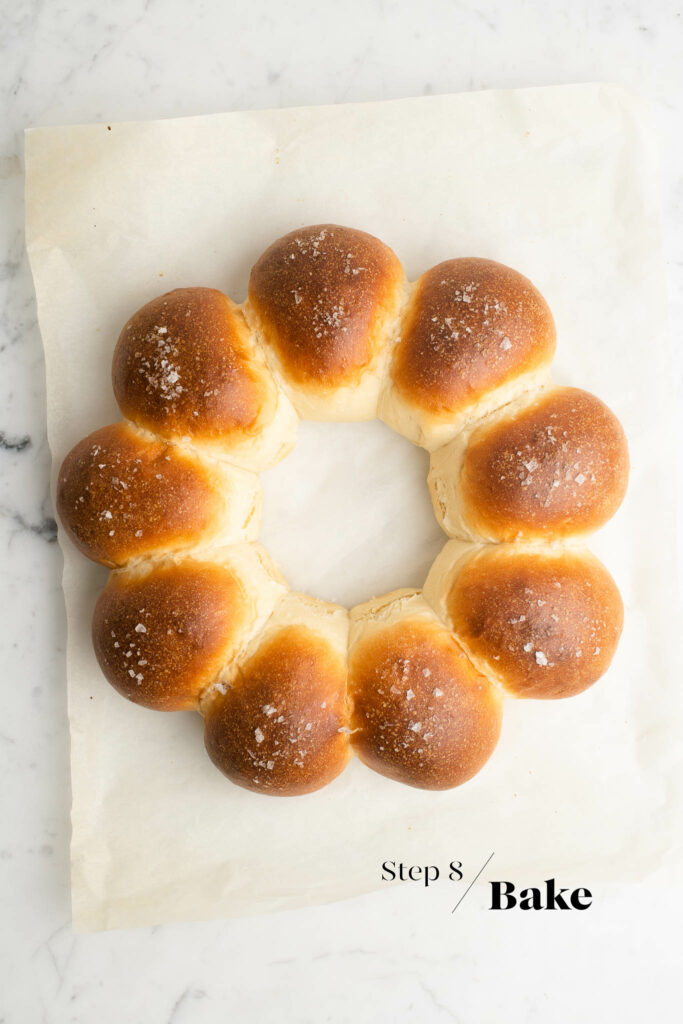
Tips for Making Baked Camembert Bread Rolls
- Use a wooden cheese box. Some soft cheeses are sold with a wooden box which can be used to warm the cheese in the oven. However, not all of these wooden boxes are suitable for using in the oven or for serving cheese – some contain holes and/or staples, others are prone to burning. Check the packaging for any information but, generally, they should not be baked in the oven for very long.
- Use a ramekin or small ceramic dish. Camembert will become very melty and liquid once baked, so I like to keep it contained by using a small ceramic dish. This has the added advantage of keeping the cheese warmer and liquid for longer.
- Use a different cheese. Feel free to use another soft cheese which bakes well, such as Brie, Vacherin Mont d’Or, or a strong cheese like Munster.
- Choose a small or large Camembert. Camembert (and Brie) come in a variety of sizes. Choose a size which is suitable for the number of people you are serving, and make sure you have the right size ramekin for that cheese. For these photos, I used a small Camembert which is 125g/4.5 oz.
- Arrange the bread rolls differently. This webpage has some great ideas for making different bread arrangements.
- Make the bread rolls ahead of time. Although nothing beats hot and freshly baked bread, you don’t necessarily need to serve the bread rolls hot for this dish. You can bake the bread ahead of time, and bake the Camembert just before serving.
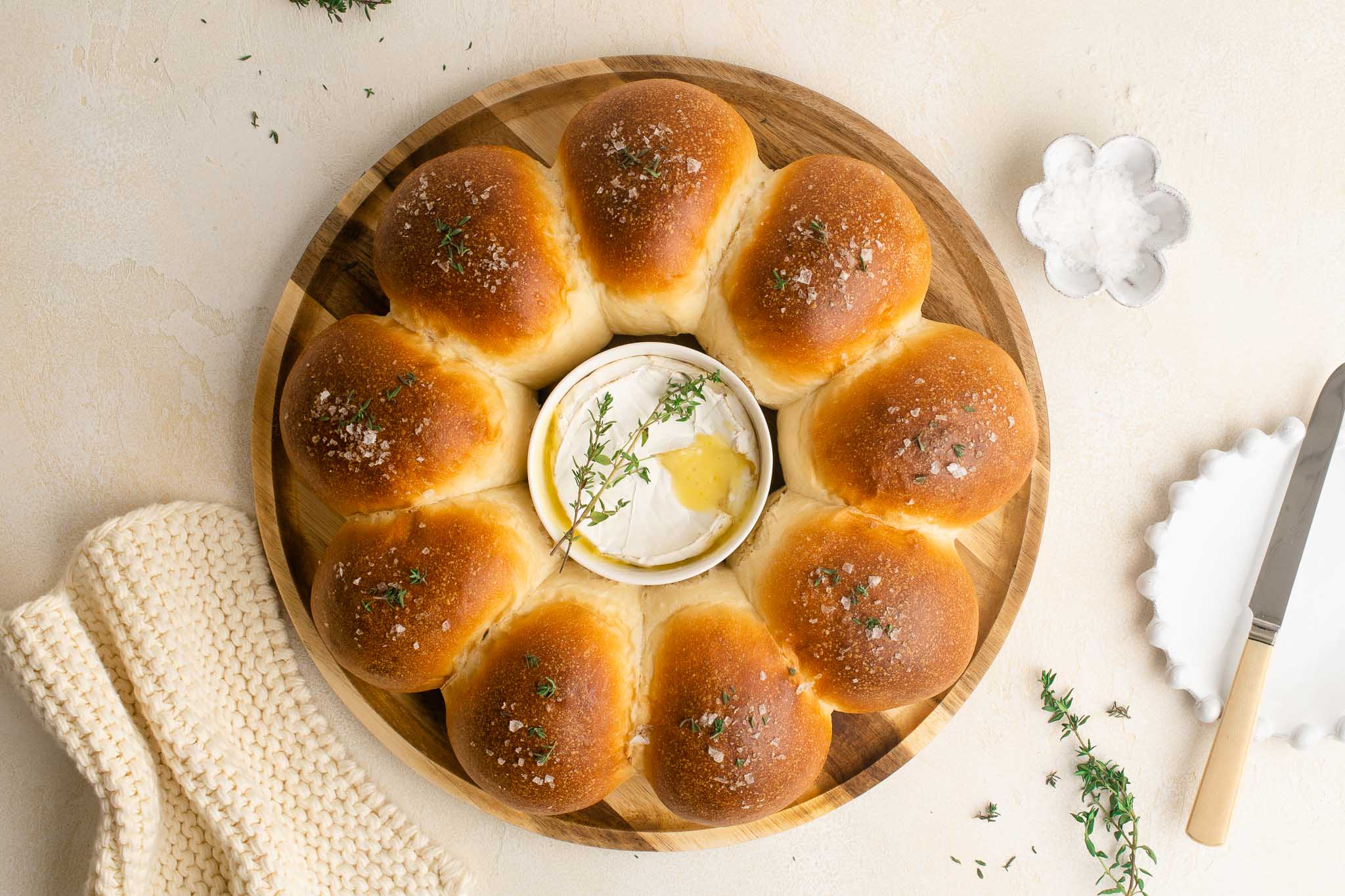
Baked Camembert Bread Rolls
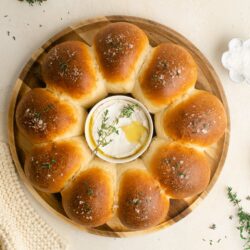
- Resting Time: 2 hours
- Prep Time: 45 minutes
- Cook Time: 25 minutes
- Total Time: 1 hour 10 minutes
- Yield: Makes 9 bread rolls
- Category: Appetiser
- Method: Oven
- Cuisine: French
For the perfect appetiser for entertaining, or simply a light meal, these deliciously soft and fluffy bread rolls with baked Camembert are sure to be a hit with your friends and family! Recipe with step-by-step photos.
Ingredients
For the Dough
- 500 g (3 1/3 cup) strong white bread flour
- 1 1/2 teaspoons fine salt
- 2 tablespoons caster sugar
- 7 g (2 teaspoons) instant yeast (see Kitchen Notes)
- 300 ml (1 cup plus 3 tablespoons) full cream milk (whole milk), warmed slightly to about 37°C/98°F
- 30 g (2 tablespoons) unsalted butter, softened
For the Bread Rolls
- 2 tablespoons full cream milk (whole milk)
- coarse sea salt flakes
- fresh thyme leaves
For the Baked Camembert
- 1 whole Camembert cheese (I used a small Camembert)
- 1–2 teaspoons dry white wine (optional)
To Serve
- finely chopped thyme or parsley, for garnish
- cornichons
- plate of cold cuts, such as salami, mortadella, ham, proscuitto
Instructions
To Make the Dough
- Measure the flour, salt, sugar and yeast into the bowl of an electric stand mixer, fitted with a dough hook.
- Lightly mix the ingredients together.
- With the speed on low, slowly add the warmed milk.
- Keep mixing on low speed until the ingredients come together into a sticky dough.
- Add the butter, about a tablespoon at a time, waiting for it to be completely incorporated before adding the next tablespoon.
- Once all of the dough ingredients have been added, mix the dough on a low-medium speed for about 15-20 minutes, or until you have a soft and smooth ball of dough. When you poke the dough gently, it should bounce back immediately.
- Lightly oil a large bowl.
- Place the dough into the bowl, and cover with some plastic wrap or a reusable bowl cover.
- Leave the dough somewhere warm for 1 to 1.5 hours, or until the dough has doubled in size (see Kitchen Notes below).
To Portion the Bread Rolls
- Remove the dough gently from the bowl.
- Weigh the dough and divide this number by 9 to get the weight for each bun.
- Divide the dough into 9 equal portions.
To Shape the Bread Rolls
- Line a large baking tray with baking paper.
- Place a small ramekin on the tray. The ramekin should be big enough to fit the Camembert.
- Roll each piece of dough into a smooth ball by pulling the edges together to form a ball, pinch the edges together, and roll gently until you have a smooth ball.
- Gently roll each ball of dough into a slightly oval shape.
- Place shaped dough onto the lined baking tray, around the ramekin. Place the buns somewhat close together so that they will touch each other after the second proofing.
- Place the tray of buns somewhere warm for about 30 minutes to puff up slightly. As they rise, the buns will touch each other and resemble petals on a flower.
To Bake
- Preheat the oven to 220°C/390°F (without fan).
- Brush the bread rolls with some milk.
- Sprinkle the bread rolls with some coarse sea salt (optional).
- Bake the bread rolls for 10 minutes.
- Reduce the oven temperature to 180°C/356°F (without fan).
- Remove any packaging from the Camembert cheese, and place the Camembert into the ramekin.
- Use a small knife to cut a cross on top of the Camembert cheese.
- If using wine, drizzle the white wine on top of the cheese.
- Continue baking the bread rolls, together with the Camembert cheese, for another 10-15 minutes. If the bread rolls are browning too quickly, cover them loosely with a sheet of aluminium foil for the remainder of the baking time.
- The bread rolls are cooked if an internal thermometer reads 85°C/185°F.
- To test if the Camembert has been baked for long enough, simply pierce the top layer to see if it is melty and gooey underneath.
- Garnish with fresh herbs before serving.
- Serve immediately.
Kitchen Notes
 DIFFERENT TYPES OF FLOUR
DIFFERENT TYPES OF FLOUR
* For Swiss readers: I use Zopfmehl (or farine pour tresse) when making bread and enriched dough.
 DIFFERENT TYPES OF YEAST
DIFFERENT TYPES OF YEAST
* Please note that there is a difference between instant yeast (also called instant dried yeast or fast-action dried yeast) and dried yeast (also called active dry yeast). If you are not sure what type of yeast you have, please check the packaging for instructions on how to use the yeast.
* With instant yeast, you can add it directly to the flour mixture without having to activate it first.
* With dried yeast, you will need to activate it first (usually in some warm liquid).
* If you are using fresh yeast, you will need about half a block (20 g fresh yeast = 7 g instant yeast). Crumble the fresh yeast into the warm milk, and stir to dissolve the yeast.
 PROOFING THE DOUGH
PROOFING THE DOUGH
Dough needs a warm environment for the yeast to activate and cause the dough to rise. If you don’t have a warm place in your home, try one of the following ideas:
* In the oven with the oven light switched on (works only for some ovens).
* In the oven with a tray of boiling water on the bottom shelf.
* In the oven or a steamer oven at a low temperature of about 25-40°C (77-104°F).
 OVEN TEMPERATURES
OVEN TEMPERATURES
All recipes on this website state temperatures for a regular oven (i.e. a conventional oven without fan). If you have a convection oven with a fan, please consult the manufacturer’s handbook on how to adjust the temperature and baking time accordingly.
 CONVERSIONS
CONVERSIONS
To convert from cups to grams, and vice-versa, please see this handy Conversion Chart for Basic Ingredients.
 Print
Print Pin Recipe
Pin Recipe Rate
Rate
These Baked Camembert Bread Rolls are like a culinary masterpiece, a delightful fusion of simplicity and sophistication! The warm, oozing Camembert nestled in the heart of those beautifully shaped bread rolls is a visual and gastronomic delight.
I can almost smell the irresistible aroma of freshly baked bread mingling with the richness of melted Camembert. Kudos to you for elevating the art of entertaining with this delightful culinary creation! 🌸🍞🧀 #BakedCamembert #BreadRolls #CheeseDelight
I just made your bread roll wreath (without the baked camembert) and it looked stunning! The bread rolls also tasted absolutely delicious, very soft and tender, excellent warm from the oven. I will definitely be making this again and again!